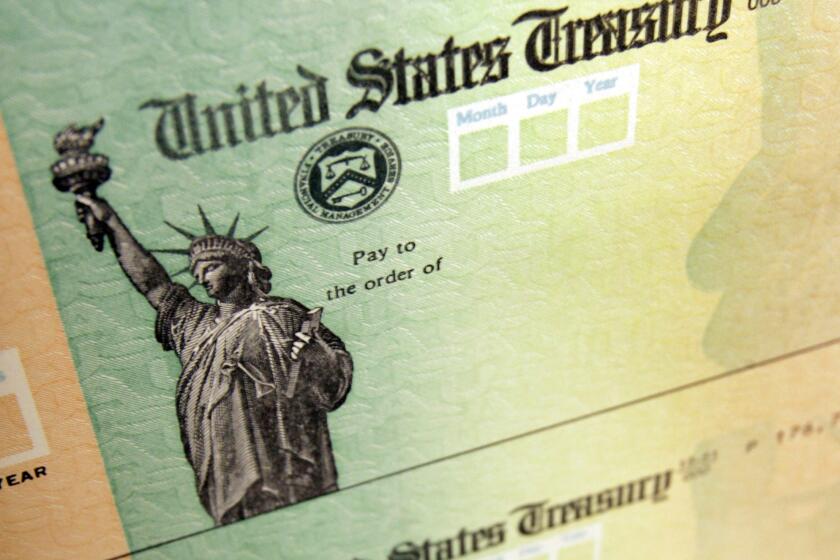House Votes to Raise Limits on IRAs, 401(k)s
- Share via
WASHINGTON — The House on Wednesday overwhelmingly approved a bill sharply increasing the contribution limits on individual retirement accounts and 401(k) plans, proposals aimed at boosting savings by Americans.
The bill is the latest in a series of tax-related measures that the Republican majority is moving through Congress. President Clinton and Democratic congressional leaders have been complaining that the bills fail to provide significant benefits for low-income people.
But in Wednesday’s vote, Democrats ignored their president and party leaders in massive numbers. The legislation passed by a lop-sided vote of 401 to 25.
The bill would increase the maximum contribution to IRA accounts from the current figure of $2,000 a year to $5,000 by 2003. For those nearing retirement--people 50 and older--the $5,000 contribution would begin next year.
The bill also would boost the amount workers may contribute to the popular 401(k) plans from $10,500 a year now to $15,000 annually by 2005.
The profits earned in these investment accounts grow tax-free.
The country’s “retirement needs have changed and the pension system has changed,” said Rep. Bill Archer (R-Texas), chairman of the House Ways and Means Committee. “This is the right legislation at the right time.”
Senate Finance Committee Chairman William V. Roth Jr. (R-Del.) said Wednesday that he is hopeful the Senate will adopt the measure later this year.
The Senate approved a similar plan last week as an amendment to a bill to repeal the estate tax, but the retirement-program provision was stripped from that legislation before final passage.
Clinton ‘Strongly Opposes’ Measure
Despite bipartisan support for the House bill, a White House statement said that Clinton “strongly opposes” the bill because, in his view, it largely would benefit higher-income people. The statement said that a “better approach” would offer savings opportunities to lower-income Americans who do not participate in pension programs.
Clinton favors government-subsidized retirement savings accounts for lower-income people that would provide a 50% federal tax credit--up to $1,000--to match worker contributions.
But the House defeated a Democratic-backed bill, 221 to 200, modeled on Clinton’s plan.
Along with passage of the retirement program bill, Congress in the last week has approved the estate tax repeal and a measure to cut taxes for married couples. But with Clinton opposing all the measures, their fate remains unclear.
The debate over pensions and savings reflects the dilemma that the country is facing over how to finance retirement of the biggest generation in U.S. history: the 76 million baby boomers born in the years 1946 through 1964.
The desire to promote savings is a way to ease dependence of workers on the Social Security system for their future income security. The average retirement benefit under Social Security is a modest $804 a month for an individual and $1,348 for a married couple, and these figures increase annually only by the rate of inflation.
For years Congress has been debating ways to strengthen other programs that encourage people to put aside money for retirement. Meanwhile, the number of traditional pension plans funded by employers has been in a steady decline--dropping from 114,000 in 1987 to 45,000 in 1997.
The emphasis has been shifting to contributions by workers themselves, either through IRAs or the 401(k) programs in which a worker contributes a portion of salary and the employer provides matching funds. More than 36 million people now participate in such plans--roughly a third of the U.S. work force--but the average account balance is only about $37,300, according to the Employee Benefit Research Institute.
Seeking More Savings, Help From Employers
The hope of lawmakers from both parties is that people can be encouraged to save more and employers can be given incentives to offer pension plans to their workers.
The discussion over the problem can become somewhat confusing because the savings rate--the amount of income people put into various accounts--can be misleading.
The profits built up from stock market investments in IRAs and 401(k)s are not counted by the government as part of the savings rate but they are substantial sums that will be available for retirement.
Still, more than 70 million Americans--about half the work force--”don’t have 401(k) plans or any other kind of pension,” noted Rep. Rob Portman (R-Ohio), one of the co-authors of the bill approved Wednesday.
“The problem is worse among small businesses--less than 20% of small businesses [those with 25 or fewer employees] offer any kind of pension coverage today,” he said.
The Republican-sponsored bill would provide most of the tax breaks to middle and upper-income individuals. A study by the Center on Budget and Policy Priorities, a liberal think tank, estimated that about 77% of the total tax savings would go to the top 20% of taxpayers--those with incomes of $67,000 a year or more.
However, the appeal of expanding the contributions to IRAs, which has been frozen at $2,000 a year since 1981, and to 401(k) plans proved tremendously popular, allowing the GOP measure to draw 182 Democratic votes.
The bill applies to both types of IRAs.
In the traditional account, an individual gets a tax deduction for the annual contribution and pays taxes when the money is withdrawn on retirement. In Roth IRAs, there is no deduction for the contribution but the earnings can later be withdrawn tax-free.
The income eligibility rules for the IRAs would remain unchanged under Wednesday’s bill.
Rep. Robert T. Matsui (D-Sacramento), an influential member of the House Ways and Means Committee and an expert on pension issues, was asked for advice by many Democrats.
“I said to my colleagues, ‘This is a bad bill, but I wouldn’t stand in the way of a moving train,’ ” said Matsui, one of the 23 Democrats who voted against the measure.
Among the California delegation, he was joined by five other Democrats: Xavier Becerra and Lucille Roybal-Allard of Los Angeles, Barbara Lee of Oakland, Bob Filner of San Diego and Pete Stark of Hayward.
Not voting among the state delegation were Joe Baca (D-Rialto), Tom Campbell (R-San Jose) and Matthew G. Martinez (D-Monterey Park).
(BEGIN TEXT OF INFOBOX / INFOGRAPHIC)
How the IRAs Would Work
Elements of a House-passed bill that boosts limits on contributions to individual retirement accounts and 401(k) plans, estimated to cost $52.2 billion over 10 years:
IRA Provisions
* Raises limits for traditional and Roth IRAs from $2,000 now to $3,000 in 2001, $4,000 in 2002 and $5,000 in 2003. Indexed for inflation thereafter.
* For individuals age 50 and up, raises limit to $5,000 in 2001.
401(k)-type Provisions
* Boosts maximum annual tax-deferred contributions from $10,500 now to $11,000 in 2001, $12,000 in 2002, $13,000 in 2003, $14,000 in 2004 and $15,000 in 2005. Indexed for inflation thereafter. Limits on employer matching contribution also increased.
* For individuals age 50 and above, contribution limits would rise to $16,000 in 2001, $17,000 in 2002, $18,000 in 2003, $19,000 in 2004 and $20,000 in 2005.
Source: Associated Press
More to Read
Get the L.A. Times Politics newsletter
Deeply reported insights into legislation, politics and policy from Sacramento, Washington and beyond. In your inbox twice per week.
You may occasionally receive promotional content from the Los Angeles Times.










